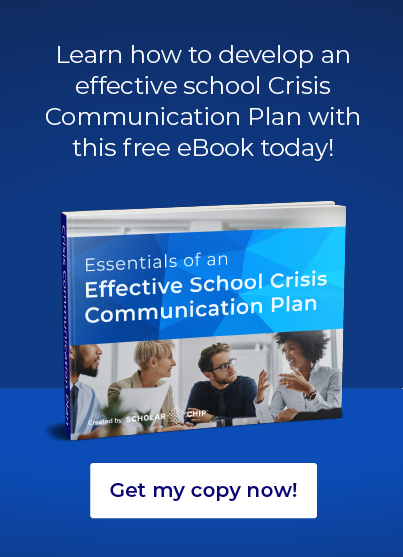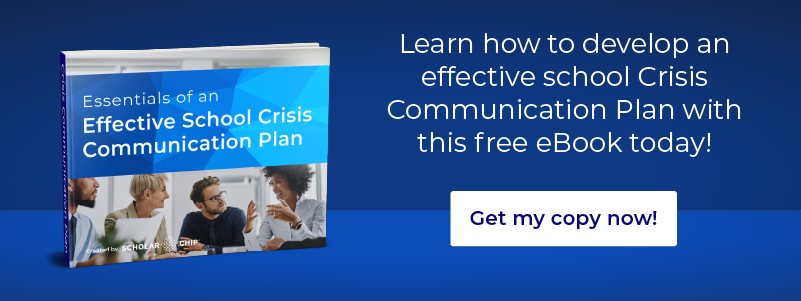Here’s an example of an emergency at one of your schools: there’s a crisis that sends all classrooms into lockdown. Students are updating their social media accounts and texting their parents. With the immediacy of these connections, you know that it’s important to communicate with stakeholders to let them know that you have the emergency under control. Otherwise, parents may panic and even drive to your campus, disrupting your emergency procedures.
However, a strong crisis communication strategy doesn’t happen only during an emergency. Instead, you need to build transparent and open relationships with parents and community members from the minute that their students enroll at your school.
Let’s go over our top crisis communication tips.
Create a Crisis Management Team and Develop a List of Stakeholders
A crisis management team comprises staff, community members, emergency services, and a spokesperson who can communicate to stakeholders. With this idea, consider the groups that need to know when an emergency arises. Stakeholders in an emergency may vary. For instance, if your school floods, a smaller number of stakeholders will be involved than if your school has an active shooter situation. Build your stakeholder list for a variety of emergency scenarios.
Experts typically recommend that only one spokesperson—generally the principal in a school-based emergency and the superintendent in a district-wide emergency—take control of communicating action plans to stakeholders, instead of trading off the spokesperson duties to various individuals.
Build Relationships with Parents
If you have a crisis at your school, parents and guardians will know about it almost immediately in our era of connected social media. So, to maintain order and prevent chaos, it’s essential to prove to parents that you will communicate with them during a crisis.
The first step is gaining parents’ trust before a crisis occurs.
“Parents want to know what’s going on. The tricky part is knowing what parents really want to hear and what will be perceived as propaganda. Parents are astute at knowing the difference,” says William Harms, a public relations specialist for Chicago independent schools.
Schools should first have courteous communications with parents via phone and email. If parents write or call with a concern, your staff should respond to them efficiently. You may also decide to create a newsletter that honestly discusses even less-than-cheery aspects of operations.
Constant communication with parents lets them know that you’ll continue connecting with them during a crisis.
Implement Tools That Provide Peace of Mind for Student Tracking
One significant crisis communication tip is proving to parents that their children will not get “lost” in an emergency situation. That’s why it’s crucial to implement tracking systems that prove to parents that you can always track their students.
ScholarChip’s One Card and Secure Door Access card readers provide this tracking security. Students are assigned a One Card with a unique identifier. They must use this card to open Secure Door Access portals to enter every room or area on campus; they can’t go anywhere on campus without being detected. With this technology, no student could ever be left behind in an emergency. Furthermore, the Secure Door Access portals can put the entire campus on lockdown with a single administrative click of a button.
After implementing this technology, inform parents about the steps that you’ve implemented for tracking their students. If they know that their children will be accounted for in an emergency, they’re less likely to drive to campus and disrupt your emergency plans.
In connection with tracking students, you also want to inform your stakeholders that you have plans for evacuating on-campus visitors if the need arises. ScholarChip’s Visitor Access Management system keeps track of every vendor, volunteer, and parent who may be on campus at a given time. (The system also adds an added layer of security by running each visitor’s identity through a sex offender registry.) In the event of an emergency, visitors won’t face any risk of being forgotten.
Explain Evacuation Plans and Emergency Preparedness to Stakeholders
Stakeholders want to be informed about how you’ll respond to a variety of situations. Once you’ve installed ScholarChip’s technology, build emergency plans for a variety of situations. Then, share these plans with parents and guardians so they can understand your plans—and the role they should play in these plans—if an issue did arise.
Use Multiple Platforms to Update and Inform Parents of Emergencies
As we’ve seen in many modern crises, misinformation and rumors often spread due to a lack of communication. Students reporting to the outside world using social media and text messages only know part of the story, and rumors are often created from partial facts.
Take control of the information proliferating around your emergency by posting information on every platform that stakeholders may use. For instance, parents should be able to opt in to receive updates via text message. At the same time, you should also update your school’s social media platforms and website, as well as radio and TV stations, as appropriate. Stakeholders should be able to tune in on whatever platform they choose and receive a consistent, reassuring message about their students’ safety.
Crisis Communication Tips: Conclusion
Most of our crisis communication tips revolve around building trusting relationships with your school’s stakeholders. Before any dangerous situations arise, it’s vital to develop crisis communication plans and be transparent with stakeholders about your preparations. This way, when an emergency arises, parents and guardians will know that your preparations will keep their students safe.
Here at ScholarChip, we’re dedicated to helping school leaders maximize the safety and well-being of students and the entire school community.
Want to develop an effective school crisis communication plan but not sure where to start? Feel free to chat with one of our school crisis communication specialists today!


